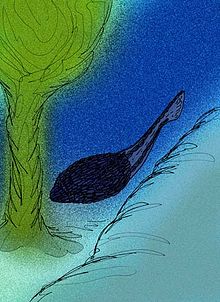Cowie Formation
| Cowie Formation | |
|---|---|
| Stratigraphic range: late Wenlock to early Ludlow or Lochkovian | |
 Shoreline near Cowie | |
| Type | Formation |
| Location | |
| Region | Scotland |
| Country | |
The Cowie Formation is geological formation located on the Highland Boundary Fault between the fishing village of Cowie and Ruthery Head, in Aberdeenshire, Scotland.[1] Age of this formation is controversial, that was originally estimated at the Middle Silurian, Wenlock to Ludlow, but zircon geochronology shows the Early Devonian, Lochkovian instead.[2] This formation preserves fossils, including a millipedes such as Pneumodesmus and Cowiedesmus that were discovered by Mike Newman in 2001,[3] and some agnathan like Cowielepis.[4]
Geological History
The sandstones and mudstones that form the outcrops along the coast were mostly laid down by braided rivers crossing a semi-arid, low-relief landscape.
One particularly exciting find was made here in 2003 when a fragment of a fossil millipede was identified as the earliest known air-breathing animal in the world. It is celebrated in a display board on the seafront at Cowie.[1]
One unusual feature of these layered sedimentary rocks is that they are tilted to the southeast at a very steep angle and therefore are seen edge on in the outcrops on the foreshore and is formally known as the Strathmore Syncline. When these layers are followed southeast for several kilometers, the degree of tilting towards the southeast is seen to decrease until the layers are almost horizontal and then steepen again as they begin to tilt towards the northwest, thus defining a broad U-shaped fold in the rock strata known as a syncline.[1]
The tilting of the strata took place when two regions of the Earth's lithosphere (the relatively rigid outer layer of the planet, which includes the crust and uppermost Mantle) were subjected to strong compressive forces over a long period. This took place between about 500 and 400 million years ago when two plates were in collision, bringing together the ancient continents of Avalonia and Laurentia. One consequence of this collision was the buckling of the thick deposits of sedimentary rocks that had, at that time, recently accumulated in this northern part of the Midland Valley.[1]
Paleobiota
According to these references[5][6][7] otherwise noted.
Color key
|
Notes Uncertain or tentative taxa are in small text; |
Vertebrates
| Vertebrates | |||
|---|---|---|---|
| Genus | Species | Notes | Images |
| Cowielepis | C. ritchiei | An anaspid.[4] |  |
| Hemicyclaspis | Indeterminate, once described as "Hemiteleaspis heintzi" | An osteostracan. |  |
| Phialaspis | P. sp. | Traquairaspidiform. | |
| Traquairaspis | T. campbelli |  | |
Aquatic arthropods
| Aquatic arthropods | |||
|---|---|---|---|
| Genus | Species | Notes | Images |
| Ceratiocaris | C. sp. | A phyllocarid. | |
| Dictyocaris | D. slimoni | Most common fossils from this site, considered as phyllocarid, while genus itself at least from other sites is identified as algae instead.[8] | |
| Nanahughmilleria | N. norvegica | Eurypterids. |  |
| Pterygotus | P. sp. | ||
| Indeterminate | Hughmilleria sp., cf. H. (?) lata | ||
Terrestrial arthropods
| Terrestrial arthropods | |||
|---|---|---|---|
| Genus | Species | Notes | Images |
| Albadesmus | A. almondi | Millipedes. | |
| Archidesmus | A. sp. | ||
| Cowiedesmus | C. eroticopodus | ||
| Pneumodesmus | P. newmani |  | |
| Indeterminate | cf. Kampecaris sp. | ||
See also
References
- ^ a b c d "Earth Science Outdoors Teachers' Guide, Cowie, Stonehaven, Aberdeenshire" (PDF). geowalks.co.uk. Scottish Earth Science Education Forum. 23 October 2009. Retrieved 30 December 2022.
- ^ Suarez, Stephanie E.; Brookfield, Michael E.; Catlos, Elizabeth J.; Stöckli, Daniel F. (28 June 2017). "A U-Pb zircon age constraint on the oldest-recorded air-breathing land animal". PLOS ONE. 12 (6): e0179262. doi:10.1371/journal.pone.0179262. ISSN 1932-6203. PMC 5489152. PMID 28658320.
- ^ "One big step for Scottish millipedes". the Guardian. 26 January 2004. Retrieved 30 December 2022.
- ^ a b Blom, Henning (2008). "A New Anaspid Fish from the Middle Silurian Cowie Harbour Fish Bed of Stonehaven, Scotland". Journal of Vertebrate Paleontology. 28 (3): 594–600. ISSN 0272-4634. JSTOR 20490987.
- ^ Westoll, T. S. (1947). "XIII.—A New Cephalaspid Fish from the Downtonian of Scotland, with Notes on the Structure and Classification of Ostracoderms". Earth and Environmental Science Transactions of the Royal Society of Edinburgh. 61 (2): 341–357. doi:10.1017/S0080456800004786. ISSN 2053-5945.
- ^ Størmer, Leif (1935). "Dictyocaris, Salter, a large crustacean from the Upper Silurian and Downtonian" (PDF). Extract Norsk Geol. Tisskr. 15: 267–298.
- ^ Wilson, Heather M.; Anderson, Lyall I. (2004). "Morphology and taxonomy of Paleozoic millipedes (Diplopoda: Chilognatha: Archipolypoda) from Scotland". Journal of Paleontology. 78 (1): 169–184. doi:10.1666/0022-3360(2004)078<0169:MATOPM>2.0.CO;2. ISSN 0022-3360.
- ^ Lamsdell, James C. (1 September 2020). "A chasmataspidid affinity for the putative xiphosuran Kiaeria Størmer, 1934". PalZ. 94 (3): 449–453. doi:10.1007/s12542-019-00493-8. ISSN 1867-6812.
- Various Contributors to the Paleobiology Database. "Fossilworks: Gateway to the Paleobiology Database". Retrieved 17 December 2021.
